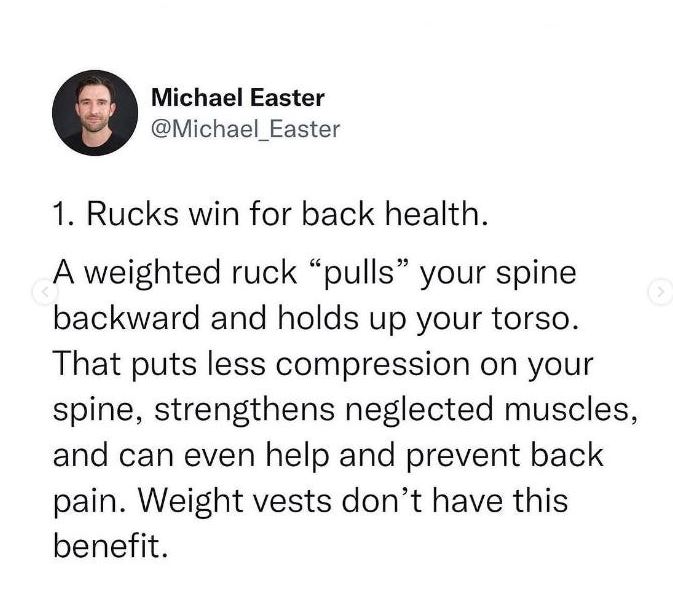There are two main options when it comes to rucking equipment: a backpack or a weighted vest.
But what is best? A backpack is the military mainstay but this puts all the weight on your back. A weighted vest, whilst looking a bit odd and having less general utility (you can’t carry things) distributes the weight on your front and back (and is typically more modular with the weight in 1kg bricks).
Ruck-X is an exercise program aimed at generation-x folks like myself, approx 40 to 65 years old. So, we also have to ask, what is better, backpack or vest, for the older rucker?
Rucking: vest or backpack?
There is an interesting post on the Michael Easter site about the pros and cons of using backpacks vs. weighted vests (1) for rucking.
I think Michael is a genuinely interesting guy who is doing a good job of promoting rucking as a powerful health and fitness tool for the masses. His post is a deep dive into the studies in an effort to answer the question (and I will save you the suspense; he favours backpacks).
Michael is also super fit, used to be the editor of Men’s Health, and is in his 30s. Therefore, I am not sure everything he says applies to the likes of ourselves (late 40s) and the Gen-X audience (40 to 60 ish) we are trying to help.
My intention with this post is to take another look at the main studies and mesh that with our own experience of rucking with backpacks and vests over the last 2 years (at ages 46 to 48 and counting).
I will then outline what I believe to be the best advice for normal folks like us, 40 years and above, health conscious but not super fit now or historically. Just normal people trying to keep strong, fit and active for the next 40 years or so!
The discussion
I believe Michaels’s post was inspired when by a thread on Twitter/X where he claimed in favour of backpacks:

A couple of rucking advocates did not really agree with this statement, which, in turn, inspired the more detailed blog post (1).
My experience with backpacks is basically that they work well to a point. They work very well with lighter loads for longer distances (10kg / 10% bodyweight). They then work okay for midrange rucks of about an hour with around 20kg or 20% of your bodyweight.
Above those kind of weights and times, I find a backpack problematic, primarily because the heavier it gets the more I kind of lean forwards to get the load over my center of gravity, and this puts strain on my neck and hips.
I feel there is some good here and this really works the core muscles, but my hips are not so happy and I can get some tendon pain and inflammation from the backpack.
With a vest I can go to about 30kg without any major issues at first, but over longer periods, the weight is all pulling down on your neck and shoulders so that can have an impact.
So what is best? Backpack or vest? Lets look at the studies and try and answer that.
Pro Backpack: the military studies
Unsurprisingly, much of the pro-backpack thinking comes from military studies (2).
The problem with these studies is that they are all done with super-fit young men in their prime.
They briefly consider injury, but if you are 40 or older, you know that the 40-year-old you is very different from the 18-year-old you—and not in a good way.
Even so, the summary of these studies kind of aligns with our own experience of regular rucking at ages 46 to 48 for over two years:
A framed pack with a hip belt reduces the incidence of rucksack palsy. Backpack load carriage can be facilitated by lightening loads, optimizing equipment, improving load distribution and by preventive action aimed at reducing the incidence of injury.
The two key points for me there are:
- Load distribution (so get that weight spread out ideally over your waist and shoulders by using a backpack with a hip belt)
- Preventative Action (warming up and doing some shoulder exercises and stretches really helps!)
My main problem here is that applying the perspective of what is right for combat soldiers does not really map to the geriatric rucker like ourselves.
The military perspective considers how someone move quickly, get into cover, have total movement of their arms etc – all important for combat situations, not so much for a 30 min ruck on your lunch break.
Even so, the takeaways are relevant for Ruck-X style rucking:
- Start light
- Use good quality kit
- Distribute the weight (front, back, waist strap etc)
- Warm-up
- Practice flexibility (this just more important every year for me)
This is all solid enough for young and old ruckers alike.
The Hong Kong Study
There is another study known as the Hong Kong Study (3), titled, Effects of backpack and double pack loads on postural stability which concluded that:
Backpack carriage significantly reduced postural stability, whereas there was no significant effect under double pack loads. Distribution of heavy loads on the front-and-back is desirable for superior balance control.
The takeaway here is clear: distributing the weight over your front and back is superior for balance control.
The big problem with backpacks is that with the weight on the back, you:
- lean forward, putting strain on the hips
- tilt your head back to account for the lean, putting strain on the neck
- weight on the back is associated with overstriding and lower body injuries
With a weighted vest, the weight is distributed evenly, and you tend to walk upright with fewer deviations from normal walking.
With a vest, you walk more normally, which is less likely to lead to injury—and injuries are more likely under heavy loads.
Backpacks vs Weighted Vests for the 40-plus
The other variables here are weight and distance.
A backpack is fine, but we switched to vests when we reached about 1/5 of our body weight at 20kg.
We then got up to about 1/3 of our weight with vests at 30kg.
We mostly rucked multiple times per week, for 90 minutes with 30kg in a vest – until we got shoulder injuries. Too much, too little variation, too heavy.
Weighted vests do balance the weight better, but that weight is all on your neck and shoulders and the soft tissue there, so it’s also easy to overdo it.
We then purchased higher-quality backpacks designed for rucking, with waist straps to distribute the weight over the back and waist. These are great, but I still can’t do much more than 20kg in a backpack without leaning too far forward.
Another consideration is the look of a vest vs a backpack. A backpack fits in anywhere and gets no questions. I am super busy, as I am sure most 40-plus folks are, so I do some of my rucks at lunchtime in a busy city, and the backpack is a better fit for this.
#1 Priority – don’t get injured
At the end of the day our goals are simple:
- improve our cardiovascular fitness
- get stronger
- lose weight (or maintain)
To do this, we have to keep exercising and avoid injury.
I am 48 and hurtling towards 50. I was okay at 40, but have found that in the last 3 years or so, and I can imagine it gets worse with more miles on the clock, it is just so easy to pick up injuries.
I was drawn to rucking as I struggled running due to knee pain and Achilles problems.
Rucking was great; I could still exercise, combining cardio and strength, so it was efficient until I injured my shoulder going too heavy for too long.
I switched to a backpack then for an extended period and developed some hip injuries (and had to take the weight down a bit).
If used in excess or at the wrong weights, both the vest and backpack can make me prone to injuries.
The backpack aggravates my hip tendons and causes pain in my outer hip.
If I wear the vest too heavy, for too long, too often, it can aggravate my neck and shoulders.
Backpack vs Weighted Vest – the Ruck-X Verdict
My feeling is that a combination of the two is the best.
- Longer & Lighter – backpack
- Shorter & Heavier – weighted vest
Both options have slightly different benefits, and both can cause overuse injuries (tendons, etc.) when used too much.
To get around this we use both in rotation and let the type of rucking we are doing dictate how we carry the weight.
- Vest – heavy and short (30kg – 30 mins)
- Backpack – midweight and midlength (20kg – 60 to 90 mins)
- Backpack – light and long (10kg – 4 to 8 hour walks)
Like many things in life, there is no simple binary answer.
I want to be able to do the short heavy rucks to keep my strength up and the vest is way better.
But I use a backpack built for rucking (with a waist strap) for most of my day-to-day rucking.
What are your experiences? We would love to hear in the comments below.
References


